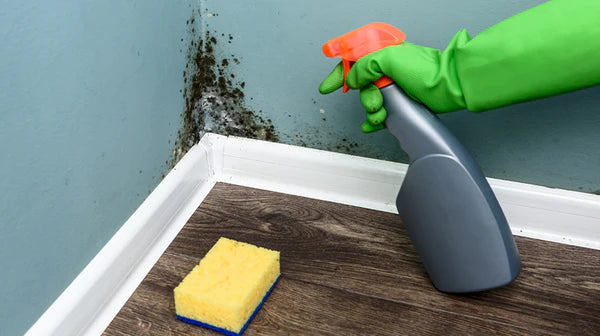Here are some tips for removing and preventing that dreaded mould and mildew from creeping into your home and property.
As the weather improves and the spring clean season begins, this is one of those tasks that you will probably be attacking first as you emerge from all that winter cabin fever. You will probably be itching to clean up all those unsightly patches forming eyesores on your property.
Find out how you can reduce the chances of it occurring, why it is so harmful and how to eradicate it once it arrives in this blog.
Why Mould & Mildew Build Up Is Harmful?

Mould and Mildew is Bad for your Health
As a form of fungi, mould and mildew spores may prove dangerous to your respiratory system and possibly life-threatening to anyone immunocompromised with asthma or suffering from an acute mould allergy. Symptoms include stuffy nose, sore throat, coughing or wheezing, burning eyes, or skin rash.
It is an Unsightly Eyesore
The presence of mould makes our exteriors and interiors look dirty and unkempt. Visibility of it at home reduces our sense of wellbeing.
What Causes Mould and Mildew to Appear ?
The answer to this question will also help you take the right measures to prevent the re-appearance of mould and mildew once you have successfully eradicated it. Mould and mildew produce spores can reproduce if left undisturbed.
What do Mould and Mildew Look Like?
Mildew is a surface fungus. It looks like a flat patch of grey or even white fungus. You’ll find it on the surface of a moist area and it gives off an unpleasant musty smell. When you touch it, it has a powdery texture.
Mould is far more dangerous. It is also a fungus and it can be black, brown, blue, green or even yellow in colour. It is often the result of a much larger fungus infestation and tends to look fuzzy. It is slimy to the touch.
How Mould and Mildew Enters Your Home
The spores can get into your home through open doors, windows, vents, and via heating and or air conditioning systems. Humans and pets can be vectors by transporting in mould spores landing on clothing, shoes, bags, and even via pets.
Like any living organism - once you provide it with the ideal conditions to flourish, it will spread rapidly. So taking away those conditions will prevent it from ever happening in the first place.
These conditions include warm, moist and humid environments such as:
- Unventilated bathrooms and kitchens
- Around leaks in roofs, windows, or pipes,
- In areas where water is accumulating regularly
- In areas where a flood has just occurred and saturated surrounding materials.
Where Can Mould and Mildew Grow in Your Home?

Saturated or permanently moist porous material helps it to grow. It can develop in the following locations once damp or sodden.
- Paper and cardboard
- Ceiling tiles
- Wood
- Dusty walls including on painted surfaces and wallpaper
- Inside insulation and drywall.
- Within carpets and along the edges of flooring
- Along grouted surfaces and in joints
- Within soft home furnishings, fabric, and upholstery
If something in your home is too infested with mould or mildew and resists cleaning, then throw it out completely - e.g. old carpets and soft furnishings - as it will infest the rest of your home.
How to Prevent the Buildup of Mildew and Mould

Keep your home well ventilated and keep humidity levels low
- Consider using an air conditioner or dehumidifier to clear the air of damp.
- Use a meter to check your home’s humidity at different times of the day or when the seasons change.
- To keep the air flowing freely through your house, you should be installing extractors and exhaust fans in kitchen and bathroom areas respectively. This is especially important if there is no window and the rooms are closed off during winter to the elements .
- Your clothes dryer vent must also be located outside your home and not situated close to the other home ventilation openings, so that the exhaust does not feed back in.
Check for damp. Fix damp areas. Remove damp items
- Fix and monitor any areas which are prone to condensation. The water buildup may collect in corners and soak into surrounding materials.
- Damp proof your walls especially if it is a period property in need of retrofitting.
- Reduce the occurrence of leaks and seal any gaps - check your roof, walls, or plumbing so mould does not have moisture to grow in unseen corners from the steady drip on an unseen leak.
- Check your windows and doors to prevent the leaking of rainwater into the house.
- Avoid the accumulation of damp house items like wetsuits and rain gear in the utility room or damp towels on the floor or in laundry baskets.
Decorate Your Home With the Right Materials
- Avoid adding carpet in damp-prone areas like carpet bathrooms for basements.
- You can add mould inhibitors to paints before painting available in Homevalue stores.
- Use Mould & Mildew Resistant paint such as
- Zinsser Permawhite Interior Satin paint - it is perfect for Kitchens, Bathrooms & High Humidity Areas being scrub & scuff resistant. It also has a 7 Year Guarantee and only needs a recoat time of 2 hours
- Ronseal Anti Mould Paint also resists moisture and steam and has a steam-resistant tough finish. It stops common mould from growing on your walls or ceilings for up to six years. Also ideal for kitchens, bathrooms, cellars and anywhere else that attracts mould.
A Cleaning regime that Prevents Mould and Mildew
- If carpets and upholstery become soaked and cannot be dried right away - remove them immediately.
- Keep your bathroom clean and regularly give it a once over with mold and mildew busting sprays and detergents.
- The simple act of vacuuming and dusting your house regularly will make it hard for surface mould and mildew to establish.
- Check and clean your shower curtains periodically - avoid soap residue to reduce the buildup of mould. Choose a material that will dry and clean easily.
- Check inside bathroom and kitchen sink containers regularly.
- Try to dry out soft furnishings and large sheets outdoors as much as possible.
- Use mould-killer detergents and sprays for example:
- Ronseal 3-in-1 Mould Killer is suitable for getting rid of mould and protects it from returning. It's immediately ready for use and kills mould on contact whilst preventing further outbreaks thus protecting against mould returning
How to Eradicate Mildew and Mould
Eradicating Mildew and Mould is a proper spring cleaning task and you will just have to buckle down and use some elbow grease in the process.
If you do it regularly as part of your routine then there's less to do in the long run. But if you let it build up, it will be a grimy, unpleasant and sweat-inducing intervention to face up to…
Steps you need to take to Kill off Mildew and Mould

Protect yourself first
- Wear a mask and don some gloves. The mask will protect your lungs from those spores and the cleaning chemicals. The gloves will protect you from any nasty chemicals if using special detergents.
- Make sure the room is well ventilated. As this will also make sure the washed area doesn’t stay damp.
Cleaning Harder surfaces
- Create a simple homemade treatment using a solution of equal parts bleach and water. Use a spray bottle to distribute it over the infested surface. Use hot water for added impact.
- Let the solution soak for 15 minutes for it to work.
- Remove the residue with a stiff bristled brush by scrubbing the area you have sprayed.
- Rinse out thoroughly with water and drain. For more impact, and for items like shower curtains, rinse with water containing one cup lemon juice and one cup salt to a gallon of hot water.
- Make sure the space is ventilated enough so it can dry out.
Cleaning carpets and soft furnishings
- Vacuum infected carpets and flooring thoroughly first to remove as much of mildew as you can off the surface.
- Then clean the carpet with a wet solution made up of 1 tablespoon of liquid laundry soap and 2 cups of cool water.
- Apply the soapy solution to the infected area with a damp cloth and sponge it lightly.
- Keep doing this until the mouldy stain has disappeared.
- Rinse the area.
- Dry the area completely.
Mould and Mildew Eradication Checklist:
Here’s a handy checklist for that job you have been dying to do all winter. Why not check our CLEANING products online catalogue section for the full range of accessories and solutions available in our shops?
Shopping list of Cleaning materials
- Protective cleaning gloves in latex of rubber
- Buckets and brushes
- Vacuum with a brush attachment
- Mop and sponges
- Lemon juice
- A Non-ammonia detergent, soap
- Disinfectant bleach
- Ronseal Anti Mould Paint
- Ronseal Anti Mould Paint 6 Year 400ml Aerosol
- Zinsser Permawhite Interior Satin 2.5L
- Ronseal 3-in-1 Mould Killer
- Evo-Stik Clear For Life Silicone Sealant
Have you successfully eradicated your mildew and mould with some home grown solutions and tricks? Got some horror stories and happy endings from your last mouldy spring clean?


